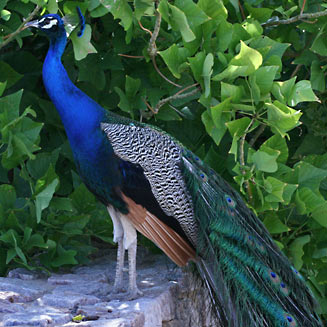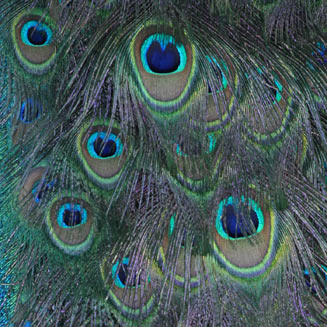|
Pavo cristatus (Common
peacock)
Makpou [Afrikaans]; Ipikoko [Xhosa]; Blauwe pauw
[Dutch]; Paon bleu [French]; Pfau [German]; Pav„o [Portuguese]
Life
> Eukaryotes >
Opisthokonta
> Metazoa (animals) >
Bilateria >
Deuterostomia > Chordata >
Craniata > Vertebrata (vertebrates) > Gnathostomata (jawed
vertebrates) > Teleostomi (teleost fish) > Osteichthyes (bony fish) > Class:
Sarcopterygii (lobe-finned
fish) > Stegocephalia (terrestrial
vertebrates) > Tetrapoda
(four-legged vertebrates) > Reptiliomorpha > Amniota >
Reptilia (reptiles) >
Romeriida > Diapsida > Archosauromorpha > Archosauria >
Dinosauria
(dinosaurs) > Saurischia > Theropoda (bipedal predatory dinosaurs) >
Coelurosauria > Maniraptora > Aves
(birds) > Order: Galliformes >
Family: Phasianidae
 |
 |
|
Male Common peacock, Klein Pella (Northern Cape).
[photo H. Robertson, Iziko ©] |
Identification
Unmistakable on basis of large size and distinctive
plumage. The blue plumage of male with its long iridescent-patterned tail that
can be spread into a fan when displaying is particularly noticeable.
Distribution and habitat
Indigenous to Pakistan, India and Sri Lanka. Introduced to
South Africa in 1968 and there are now naturalised populations on Robben Island, Cape
Peninsula, Port Elizabeth and East London.
Predators and parasites
None recorded in southern Africa.
Food
Ominivorous, diet includes seeds, leaves, fruit,
invertebrates (insects, worms, centipedes, etc). Also known to eat lizards,
small snakes and small mammals.
Breeding
- Male has a harem of 2-5 females. He fans out his
impressive tail in an elaborate courtship with a female.
- The nest consists of a shallow scrape in the ground
lined with leaves and sticks and hidden away in thick vegetation. Also known
to nest in buildings, hollows, and in large trees.
- The female lays 3-12 eggs (usually 3-6) at two day
intervals and starts incubating them after the fifth or sixth egg has been
laid. She incubates them for 28-30 days.
- Chicks are active with 2 hours of hatching. The female
teaches them to feed by pointing with her beak to food items. The young
birds stay with the female for 5-6 months.
References
-
Hockey PAR, Dean WRJ and Ryan PG (eds) 2005. Roberts
- Birds of southern Africa, VIIth ed. The Trustees of the John Voelcker
Bird Book Fund, Cape Town.
Text by Hamish Robertson |
